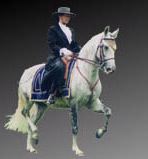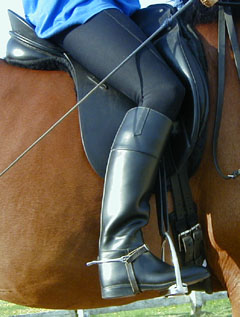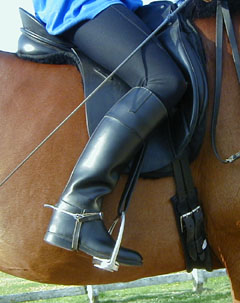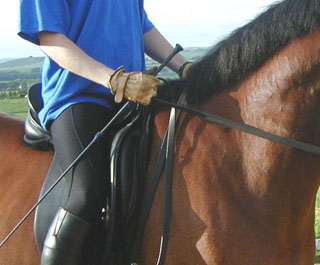 |
classicaldressagescotland.com |
| Lesson 5: The rider's aids (part two - How to apply them) |
| New web address: www.classicaldressagescotland.com |  |
| About this site | About us | Personal Tuition | Video analysis | Lesson menu | Portugal and Lusitanos |
| Home Schooling Classical dressage Modern dressage Horse trials Show jumping Glossary Links |
An aid is the signal or means by which a rider
conveys his or her wishes to his horse. It refers to any action
by the rider which results in physical or mental communication
between horse and rider. These are divided into two parts: -
Natural Aids - The rider's legs, hands, seat and back, balance and voice. Artificial Aids - Whips spurs and any form of strap, rope or gadget (other than the reins) which control or position the horse, with or without a rider. Examples might be standing or running martingales, draw or running reins. Only the whip and spur have a place in classical dressage, however, gadgets on rare occasions could be the only solution to a severe or even a dangerous problem and will be discussed in future lessons and e-mails. Natural AidsThe LegsThe major influences are to
The effect of using both legs on the girth is to encourage the horse to move forward. When first handled, any horse will react to human contact by withdrawing from it. As flight is their natural defence, when first mounted and feeling the legs of the rider against the rib cage, the reaction is to move forward and away from the pressure. This is the basis of all training. By constant repetition and training, the slightest pressure with the inside of the rider's leg will result in the horse moving forward (off the leg). Individual use of the Legs Once this reaction of moving forward is established
the application of either of the rider's legs by the girth, or
slightly behind the girth, will encourage the horse to move the
hind leg on that side forward. Since it will also be instinctive
for the horse to try to yield to the pressure on the ribs it
will also tend to bring
Applying the Leg Aids
The HandsThe major influences are to;
The hands are only supplementary and complementary to the seat and leg aids. Except for the very young horse where the hands and reins are used to guide and lead. Applying the Hand Aids Through the reins and the bit the hands are a direct connection to the horse's brain and their use has a paramount effect on its mental and physical attitude. To be most effective the hands should
Individual use of the HandsWill be covered in future lessons. Seat and BackWill be covered in future lessons.BalanceWill be covered in future lessons.VoiceThe voice by its tone can encourage, correct, soothe or reward. It is also used to give commands, particularly on the lunge and with a young horse when it is first ridden. The horse learns that sharp quick commands 'walk-on' 'trot', 'canter' mean to go forward, and low and drawn-out 'woaah' 'waalk', 'teerrot' to reduce the pace. Artificial Aids
I have already covered some of the theory
of using whips and spurs in 'The Theory of Aids' but I will expand
a little in this chapter. The first things to remember are these:
Application When the whip is not in use, carry the whip across either thigh, mid way between knee and hip. It will help you to control the whip if you hold the whip with your thumb up the shank or handle. It should be used behind the leg to emphasise the aid or to ask for more attention.
The spursLike the whip the spurs help to reinforce the leg aids should they prove insufficient.Application When used, the spurs should only brush the skin. Spurs are a refinement of the aids and should not be used as a sole means of creating impulsion. Consequently, the rider must be able to apply his legs without the spurs touching the horse. Spurs are rarely used in the early training of a horse and are not suitable for use by a novice rider. The type of spur you use must be personal preference. I prefer those with about a 1 inch shank and a smooth rowel that can just roll up the horses side and not dig in. Spurs with sharp toothed rowel or pointed shanks have no place in classical dressage so will not be discussed. Other Artificial Aids(gadgets, specialised reins, etc)Future lessons and by emails Remember - the artificial aids are ONLY brought into action if the legs are not effective.Good luck with this lesson. If you have any problems with your aids or you are confused as to what aids to use when, or, the aids as I have described them just don't work, please email me. If there is a problem then we must find the solution.
|

 the leg forward and slightly under the weight of
the body before turning the hindquarters away from the pressure.
This effect is used to move the horse laterally (sideways).
the leg forward and slightly under the weight of
the body before turning the hindquarters away from the pressure.
This effect is used to move the horse laterally (sideways). The
schooling whip is used for schooling on the flat. It should be
between 0.9 metres (3ft) and 1.2 metres (4ft) so that it is long
enough to apply without taking the hand off the rein. The wrist
and forearm is flicked to result in a tickle or a tap whenever
required, behind the rider's leg. The strike must be behind the
riders' leg so that your horse can associate the whip and leg.
The shorter whip, used for jumping, must not exceed 75 cms (30
ins). The whip hand should be taken off the rein and both reins
held in one hand and the whip applied behind the leg. The rider
should practice this action and the ability to change whip hands.
The
schooling whip is used for schooling on the flat. It should be
between 0.9 metres (3ft) and 1.2 metres (4ft) so that it is long
enough to apply without taking the hand off the rein. The wrist
and forearm is flicked to result in a tickle or a tap whenever
required, behind the rider's leg. The strike must be behind the
riders' leg so that your horse can associate the whip and leg.
The shorter whip, used for jumping, must not exceed 75 cms (30
ins). The whip hand should be taken off the rein and both reins
held in one hand and the whip applied behind the leg. The rider
should practice this action and the ability to change whip hands.